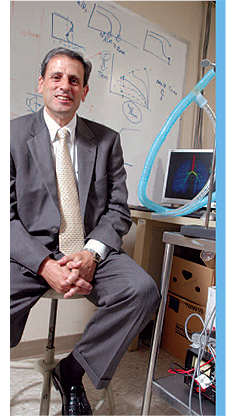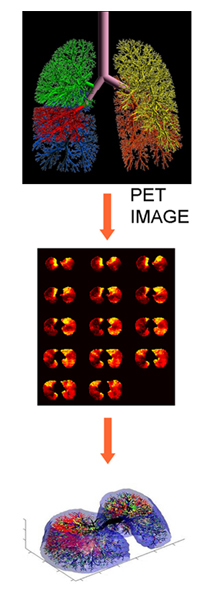Moving Research into Action
 Ken Lutchen: A New View of Asthma Ken Lutchen: A New View of Asthma
Another researcher helping people breathe easier is biomedical engineer Ken Lutchen. Recently appointed Dean of the College of Engineering, Lutchen has chaired the Department of Biomedical Engineering for the past eight years and spearheaded both the $14 million Whitaker Leadership Award and the Coulter Foundation translational research grant. At the same time he has been actively engaged in teaching and mentoring students as well as working in the lab where he is developing a new understanding of how airways constrict during asthma attacks.
Asthma is a rapidly growing disease. It currently affects 300 million people worldwide and is increasing at a rate of 50% every decade according to the Canadian Lung Association. Lutchen is developing an image-driven modeling system to give doctors a real-time picture of what happens in the lungs during an attack so that they will be able to design more personalized and effective treatments.
 When people suffer an asthma attack, the inflamed airways constrict, reducing their size and making it more difficult for air to flow freely. In some patients asthma attacks occur when the immune system overreacts to allergens like pollen or dander. In other patients inflammation is provoked by a wide variety of factors, including stress and exercise. When attacks occur, most patients take medications to minimize inflammation and relax the muscles of the lungs. When people suffer an asthma attack, the inflamed airways constrict, reducing their size and making it more difficult for air to flow freely. In some patients asthma attacks occur when the immune system overreacts to allergens like pollen or dander. In other patients inflammation is provoked by a wide variety of factors, including stress and exercise. When attacks occur, most patients take medications to minimize inflammation and relax the muscles of the lungs.
Just as the causes of asthma can vary, the reaction of the lungs can differ as well. The airways in the lungs are like intricately branching trees. In some patients, asthma may constrict many of the smallest branches farthest away from the main trunk. In other patients, fewer but larger branches may constrict.
If doctors knew the pattern of airway constriction in a particular patient, they could tailor medications to respond to that pattern. Lutchen’s image-based modeling system may be able to give doctors this information. His system feeds information from a three-dimensional MRI image of the lungs and data about how much air is moving in and out of the lungs into a computer model. The model calculates which size airways must be closing down to produce this pattern of response.
Tests so far have shown that in most patients, very small airways contribute to asthma attacks in very big ways. Armed with this information about each patient’s response, doctors can choose those drug therapies that best target the affected airways—and help asthma patients breathe a little easier.
For more information, see www.bu.edu/dbin/bme/faculty/?prof=klutch.
— by Trina Arpin
|






 Ken Lutchen: A New View of Asthma
Ken Lutchen: A New View of Asthma  When people suffer an asthma attack, the inflamed airways constrict, reducing their size and making it more difficult for air to flow freely. In some patients asthma attacks occur when the immune system overreacts to allergens like pollen or dander. In other patients inflammation is provoked by a wide variety of factors, including stress and exercise. When attacks occur, most patients take medications to minimize inflammation and relax the muscles of the lungs.
When people suffer an asthma attack, the inflamed airways constrict, reducing their size and making it more difficult for air to flow freely. In some patients asthma attacks occur when the immune system overreacts to allergens like pollen or dander. In other patients inflammation is provoked by a wide variety of factors, including stress and exercise. When attacks occur, most patients take medications to minimize inflammation and relax the muscles of the lungs.